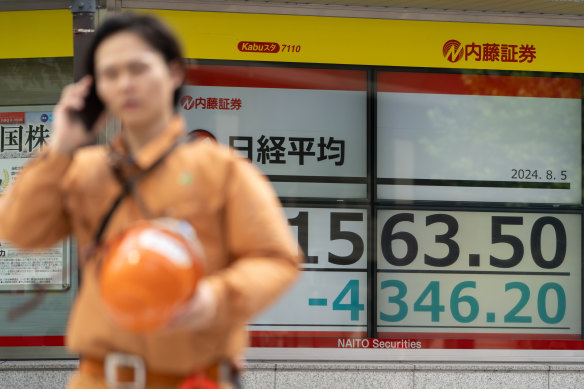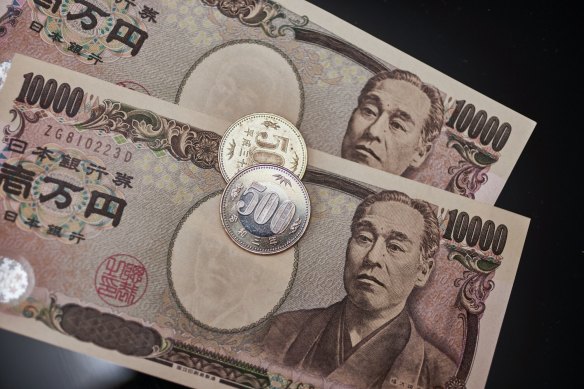‘It got spooky’: Inside the three days of chaos that rocked Japan
By River Akira Davis
Over the past week, markets tumbled as fears ricocheted around the world about the health of the US economy, tech sector and more. No market bore the brunt as much as Japan.
A key Japanese stock index, starting last Thursday, experienced its most severe two- and three-day trading drops since the 1950s — declines that analysts said could not be fully explained by the same factors affecting other countries.

A worker walks past monitors displaying the Nikkei 225 Stock Average figure outside a securities firm in Tokyo on Monday.Credit: Getty Images
Japan had one unique element exacerbating its problems. Its weakened currency, which had been inflating corporate profits and valuations, was beginning to appreciate at an alarming rate.
The turmoil has threatened one of the most enduring stock rallies in Japan in decades. Many reasons have been given for the strong performance of Japanese stocks starting early last year. Warren Buffett’s Berkshire Hathaway expressed optimism about Japan as an alternative investment to China. The Tokyo Stock Exchange ramped up pressure on companies to enhance shareholder returns.
However, as the yen strengthened over the past week, it erased much of the gains Japanese stocks had accrued this year. Investors have been left reassessing whether the much-hailed renaissance in Japanese equities was more a result of a weakened yen than of underlying structural changes.
“Why was the rapid downturn so much worse in Japan than in other markets? The yen is top of hierarchy,” said Stefan Angrick, a senior economist at Moody’s Analytics in Japan. “Japan’s rally ultimately had a lot to do with the yen, and what happened over the past few days has been a good reminder of that.”
The weak yen played a crucial role over the past few years in supporting the shares of major Japanese companies, especially exporters that saw the value of their earnings overseas boosted. Many of Japan’s signature global brands, including Toyota, reported record profits. That drew money from investors and drove Japanese indexes to record highs.
The yen’s slide in value over the past few years was primarily caused by a large gap between interest rates in Japan and the United States. While US rates surged, Japanese rates remained below or near zero, prompting investors to seek higher returns outside Japan.
That dynamic began to reverse July 31, when the Bank of Japan unexpectedly raised its key interest rate for only the second time in nearly two decades. This move, coupled with indications from the US Federal Reserve of imminent rate cuts, led to a swift appreciation of the yen.

Japan’s yen was central to the market meltdown. Credit: Bloomberg
Last Friday, the yen, which had been trading around 161 to the dollar just weeks earlier, had crossed below 150.
The breach of the 150 yen-to-dollar threshold, which traders viewed as a tipping point, exacerbated panic among investors who feared that companies would have to lower their profit forecasts.
The Topix index, which represents a broad spectrum of the Japanese economy, dropped 6.1 per cent last Friday — capping off its worst two-day performance since the 2011 earthquake and tsunami.
After the sell-off, the start of trading in Tokyo on Monday was seen as a test of whether confidence in Japanese companies would persist even without the yen’s support. Historically, Japanese investors have seized opportunities during foreign-led market meltdowns, and prices were low.
The problem was that this time, the buyers hung back. Japan’s trading day was marked by a frenzy of selling: the Nikkei 225 Index, another benchmark index, posted its largest one-day point drop ever. Some called it “Black Monday”, recalling the global stock market crash in October 1987.
“After all of these reforms and stability and the Tokyo Stock Exchange pushing for better capital returns, you still saw no bid from the Japanese investor,” said Jesper Koll, a director at Monex Group, a financial services firm. “It got spooky,” he said.
On Tuesday, Japanese shares began to recover. The Nikkei 225 Index rebounded by 10.2 per cent, and some traders speculated that the market might have reached a settling point after factoring in a stronger yen.
One 43-year-old Japanese investor who asked not to be named, a former operator of a cram school in the Tokyo area, said that despite feeling “scared and wanting to escape”, he bought stocks on Monday. When prices rebounded he pocketed the equivalent of around $US2700 ($4121) and went off to take his children to a play centre.
The question — which no one, of course, can answer — is whether the weak-yen, high-stock-price bubble has fully deflated.
On Wednesday, Japanese indexes continued to recover, though movements were relatively small. The Nikkei 225 closed up 1.2 per cent, while the Topix gained 2.3 per cent. Japanese indexes had broadly returned to where they were at the start of the year.
Nomura Research Institute, in a note, suggested that the weaker yen started pushing stock prices higher at the start of 2023, when the Nikkei was hovering around 26,000. That could mean that stocks might fall by another third from where they are now if all of the yen-related rally reverses. For many companies and their investors, that would be a painful adjustment.
Joy Yang, who leads Asian economic research at Point72, a hedge fund, said she is waiting to make judgments on Japan’s economy and stocks until markets have calmed and several key indicators are released. For example, economic output figures due next week will show whether newfound inflation in Japan is helping stir growth, she said.
“For now,” Yang said, “we are waiting for the markets to settle, and we’ll see how to go forward from there.”
This article originally appeared in The New York Times.
The Market Recap newsletter is a wrap of the day’s trading. Get it each weekday afternoon.